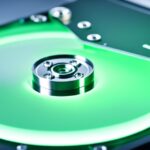Digital Data Wiping Techniques: Ensuring Complete Information Erasure
Data wiping, also known as data erasure, is the process of overwriting existing data on storage devices to make it unrecoverable. It is important for safeguarding personal and confidential information, complying with data protection regulations, preventing identity theft, and protecting intellectual property.
There are different types of data wiping methods, including single pass, multiple passes, DoD standard, and NIST recommendations. Data wiping offers benefits such as data protection, compliance, intellectual property preservation, and identity theft prevention.
The process of data wiping on a PC involves backing up important data, choosing a reliable data wiping tool, selecting the drive or partition to be wiped, choosing the appropriate data wiping method, starting the data wiping process, verifying the completion of data wiping, and optionally reinstalling the operating system or restoring data from backup. Plexstar is a trusted provider of safe and effective data wiping services.
What is Data Wiping?
Data wiping, or data erasure, refers to the process of overwriting existing data on storage devices to make it unrecoverable. This method is used for safeguarding personal and confidential information by eliminating all traces of data from devices such as hard disk drives, solid-state drives, and USB flash drives. By permanently erasing data, data wiping ensures that sensitive information cannot be accessed by unauthorized individuals, providing a reliable method for protecting privacy and preventing data breaches.
Data wiping is an essential practice in maintaining data security and complying with data protection regulations. It offers individuals and organizations peace of mind by ensuring that their sensitive information is completely and irreversibly removed from storage devices, making it virtually impossible to recover. Whether it’s personal data, financial information, or intellectual property, data wiping provides a secure and effective solution for the permanent erasure of data.
For a visual representation, consider the following table:
| Storage Device | Data Wiping Method |
|---|---|
| Hard Disk Drives | Multiple Passes |
| Solid-State Drives | DoD Standard |
| USB Flash Drives | Single Pass |
Data wiping methods vary depending on the type of storage device. For hard disk drives, multiple passes are often recommended to ensure complete data erasure. Solid-state drives, on the other hand, typically follow the DoD standard, which adheres to strict guidelines for secure data wiping. USB flash drives, being smaller and less complex, may require only a single pass to make the data unrecoverable.
Using data wiping techniques provides individuals and organizations with the confidence that their data is securely erased, reducing the risk of unauthorized access, data breaches, and identity theft. Moreover, it serves as a proactive measure to maintain data privacy and comply with relevant data protection regulations.
Quote:
“Data wiping ensures that sensitive information remains confidential and irretrievable, providing peace of mind and protecting against potential risks.”
When it comes to data wiping, the secure and irreversible erasure of data is paramount. With the right methods and tools, individuals and organizations can ensure the complete elimination of sensitive information, making it unrecoverable and safeguarding their privacy.
Why is Data Wiping Important?
Data wiping plays a crucial role in ensuring data privacy, compliance with regulations, preventing identity theft, and protecting intellectual property. Let’s explore the key reasons why data wiping is vitally important:
- Data Privacy and Security: Data wiping ensures that sensitive information remains inaccessible to unauthorized individuals. In today’s digital era, where data breaches and identity theft are prevalent, safeguarding data privacy and security is paramount.
- Compliance with Regulations: Regulations such as GDPR, HIPAA, and PCI DSS require organizations to securely erase data before disposing of storage devices. Data wiping ensures compliance with these regulations, mitigating the risk of non-compliance penalties.
- Identity Theft Prevention: By thoroughly removing personal information from devices, data wiping significantly reduces the possibility of identity theft and fraud. It eliminates the traces of personal data that could be exploited by cybercriminals.
- Intellectual Property Protection: Data wiping helps preserve trade secrets and intellectual property by securely erasing confidential information from storage devices. This ensures that valuable business secrets do not fall into the wrong hands, protecting companies from potential harm.
Overall, data wiping is crucial for maintaining data privacy, complying with regulations, preventing identity theft, and safeguarding intellectual property. Implementing effective data wiping practices helps organizations and individuals mitigate potential risks and ensure the secure disposal of sensitive information.
| Benefits of Data Wiping | Description |
|---|---|
| Data Privacy and Security | Ensures that sensitive information remains inaccessible, protecting individuals and organizations from data breaches. |
| Compliance with Regulations | Helps meet legal requirements for securely erasing data before disposal, avoiding non-compliance penalties. |
| Identity Theft Prevention | Reduces the risk of identity theft by removing personal information from devices, minimizing fraud possibilities. |
| Intellectual Property Protection | Preserves trade secrets and valuable proprietary information, safeguarding a company’s competitive advantage. |
Different Types of Data Wiping
When it comes to data wiping, there are various methods available to ensure that sensitive information is securely erased. Understanding these different data wiping methods can help individuals and organizations make informed decisions based on their specific security needs and compliance requirements.
Single Pass
The single pass method involves overwriting data with random patterns once. This makes it difficult for any traces of the original data to be recovered. While it provides a basic level of data security, it may not be sufficient for highly sensitive information.
Multiple Passes
Multiple passes, on the other hand, involve overwriting data multiple times with random patterns or specific algorithms. This provides enhanced data security by making it even more difficult to recover any remnants of the original data. The number of passes can vary depending on the desired level of security.
DoD Standard
The DoD (Department of Defense) standard follows specific guidelines, such as DoD 5220.22-M, for secure data erasure. This standard ensures that data is overwritten multiple times with specific patterns to prevent any possibility of recovery. It is often required for organizations that handle classified or sensitive information.
NIST Recommendations
The NIST (National Institute of Standards and Technology) provides recommendations for effective data wiping in their Special Publication 800-88. These recommendations offer guidance on different data wiping methods, including the number of passes and the use of specific algorithms, to ensure data security in various contexts.
By utilizing these different data wiping methods – single pass, multiple passes, DoD standard, and following NIST recommendations – individuals and organizations can effectively protect sensitive information, safeguard privacy, and comply with relevant data protection regulations.
| Method | Description |
|---|---|
| Single Pass | Overwriting data with random patterns once |
| Multiple Passes | Overwriting data multiple times with random patterns or specific algorithms |
| DoD Standard | Secure data erasure following DoD guidelines |
| NIST Recommendations | Guidelines provided by the National Institute of Standards and Technology |
Each method offers a different level of data security and should be evaluated based on specific requirements and compliance standards. It is recommended to consult with data wiping experts, like Plexstar, to determine the most appropriate method for your needs.
Benefits of Effective Data Wiping
Effective data wiping provides numerous benefits for individuals and organizations. By permanently erasing data, it offers robust data protection, preventing unauthorized access and safeguarding sensitive information. This ensures that confidential data remains secure, mitigating the risk of data breaches and unauthorized use.
Furthermore, data wiping plays a crucial role in compliance with data protection regulations. By securely erasing data from storage devices, organizations can adhere to legal requirements, reducing the likelihood of non-compliance penalties. This fosters trust and transparency with stakeholders, reinforcing a commitment to data privacy.
In addition to data protection and compliance, effective data wiping helps preserve intellectual property and trade secrets. By erasing all traces of data from storage devices, it ensures the confidentiality and integrity of valuable information. This is particularly important for industries where intellectual property is a key asset, such as technology, research and development, and creative sectors.
Last but not least, data wiping is instrumental in preventing identity theft. By removing personal data from devices, it minimizes the risk of fraudulent activities and unauthorized use. This serves as a proactive measure to safeguard individuals’ identities and sensitive personal information, promoting peace of mind and protecting against potential financial and reputational harm.
Overall, effective data wiping offers a comprehensive range of benefits, including data protection, compliance, intellectual property preservation, and identity theft prevention. By implementing robust data wiping practices, individuals and organizations can ensure the secure disposal of data, contributing to a safer digital environment.
Conclusion
In today’s digital age, data wiping is an essential practice for protecting sensitive information and ensuring data privacy. With the increasing reliance on digital storage devices, it is crucial to understand the importance of data wiping and the various methods available.
Data wiping involves permanently erasing data from storage devices, making it unrecoverable. This process helps safeguard personal and confidential information, preventing unauthorized access and potential data breaches. By following the step-by-step instructions provided, individuals and organizations can confidently perform data wiping on their PCs.
By prioritizing data wiping, we contribute to a safer and more secure digital environment. It not only protects privacy but also keeps sensitive information out of the wrong hands. Additionally, data wiping ensures compliance with data protection regulations, such as GDPR, HIPAA, and PCI DSS.
If concerns about data privacy persist, it is recommended to seek expert support from a trusted provider like Plexstar. Their services ensure effective data wiping, offering peace of mind and mitigating the risk of data compromise. Prioritizing data wiping is vital for sensitive information security and maintaining data privacy in today’s interconnected world.
FAQ
What is data wiping?
Data wiping, also known as data erasure, is the process of overwriting existing data on storage devices to make it unrecoverable.
Why is data wiping important?
Data wiping is important for safeguarding personal and confidential information, complying with data protection regulations, preventing identity theft, and protecting intellectual property.
What are the different types of data wiping methods?
The different types of data wiping methods include single pass, multiple passes, DoD standard, and NIST recommendations.
What are the benefits of effective data wiping?
The benefits of effective data wiping include data protection, compliance, intellectual property preservation, and identity theft prevention.
How can I perform data wiping on a PC?
The process of data wiping on a PC involves backing up important data, choosing a reliable data wiping tool, selecting the drive or partition to be wiped, choosing the appropriate data wiping method, starting the data wiping process, verifying the completion of data wiping, and optionally reinstalling the operating system or restoring data from backup.
Are there trusted providers of data wiping services?
Yes, Plexstar is a trusted provider of safe and effective data wiping services.















